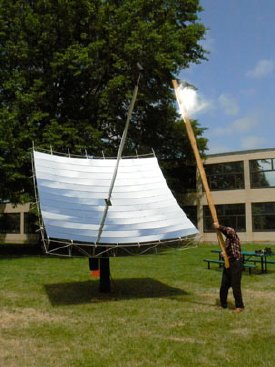Jun 19 2008
A team led by MIT students this week successfully tested a prototype of what may be the most cost-efficient solar power system in the world--one team members believe has the potential to revolutionize global energy production.

The system consists of a 12-foot-wide mirrored dish that team members have spent the last several weeks assembling. The dish, made from a lightweight frame of thin, inexpensive aluminum tubing and strips of mirror, concentrates sunlight by a factor of 1,000--creating heat so intense it could melt a bar of steel.
To demonstrate the system's power, Spencer Ahrens, who just received his master's in mechanical engineering from MIT, stood in a grassy field on the edge of the campus this week holding a long plank. Slowly, he eased it into position in front of the dish. Almost instantly there was a big puff of smoke, and flames erupted from the wood. Success!
Burning sticks is not what this dish is really for, of course. Attached to the end of a 12-foot-long aluminum tube rising from the center of the dish is a black-painted coil of tubing that has water running through it. When the dish is pointing directly at the sun, the water in the coil flashes immediately into steam.
Someday soon, Ahrens hopes, the company he and his teammates have founded, called RawSolar, will produce such dishes by the thousands. They could be set up in huge arrays to provide steam for industrial processing, or for heating or cooling buildings, as well as to hook up to steam turbines and generate electricity. Once in mass production, such arrays should pay for themselves within a couple of years with the energy they produce.
"This is actually the most efficient solar collector in existence, and it was just completed," says Doug Wood, an inventor based in Washington state who patented key parts of the dish's design--the rights to which he has signed over to the student team.
Wood credits the students who built this dish, as an independent project that started in January, with making significant improvements to his original design to make it a practical and competitive energy producer. "They really have simplified this and made it user-friendly, so anybody can build it," he says.
One of the keys to making an inexpensive design was something Wood discovered by accident as he built a variety of solar dishes over the years: Smaller really is better. Unlike many technologies where economies of scale dictate large sizes, a smaller dish requires so much less support structure that it ends up costing only a third as much, for a given collecting area.
MIT Sloan School of Management lecturer David Pelly, in whose class this project first took shape last fall, says that, "I've looked for years at a variety of solar approaches, and this is the cheapest I've seen. And the key thing in scaling it globally is that all of the materials are inexpensive and accessible anywhere in the world."
Pelly adds that "I've looked all over for solar technology that could scale without subsidies. Almost nothing I've looked at has that potential. This does."
The team, led by Ahrens, also includes Micah Sze (Sloan MBA '08), UC Berkeley graduate and Broad Institute engineer Eva Markiewicz, Olin College student Matt Ritter and MIT materials science student Anna Bershteyn. Various other students also helped out over the course of the semester.